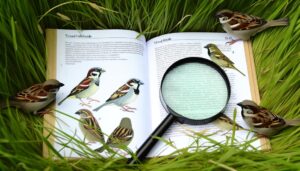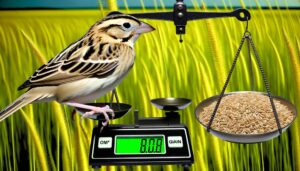Clay-colored Sparrow Vs Chipping Sparrow – 3 Key Differences
The Clay-colored Sparrow and Chipping Sparrow are distinctly different. The Clay-colored sparrow has earthy hues with a pinkish beak, thriving in North America's open shrublands, while the Chipping Sparrow sports a rusty cap, black eyeline, and gray face, preferring open woodlands, fields, and backyards.
Their dietary habits vary seasonally, but primarily consist of seeds, insects, and berries. Clay-colored Sparrows display complex mate selection rituals, while Chipping Sparrows are known for their trilling song, used for territorial establishment.
Venturing further will reveal more intriguing facts about their environments, behavior pattern, and diverse biology.

Key Takeaways
- Clay-colored Sparrows have a grayish-brown color with dusky streaks, while Chipping Sparrows have a rusty cap and a black eye-line.
- Clay-colored Sparrows are found in open shrublands of North America, whereas Chipping Sparrows inhabit open woodlands, fields, parks, and backyards.
- Both species feed on insects and seeds, but Chipping Sparrows show a preference for grass seeds.
- Clay-colored Sparrows engage in complex mating rituals with males performing courtship displays, while Chipping Sparrows use a distinct trilling song for territorial establishment.
- Clay-colored Sparrows are found in shrubby areas and grasslands, while Chipping Sparrows are commonly spotted in open woodlands and parks.
Understanding Sparrow Basics
One must first understand that sparrows, tiny yet resilient creatures, exhibit a fascinating array of characteristics worthy of scientific observation and study. Primarily, sparrows are small, plump, brown-grey birds with short tails and stubby, powerful beaks. They're known for their ability to adapt to varied environments, from urban areas to wild landscapes.
Sparrows feed mainly on seeds, but they'll consume insects when available, making them omnivorous. They're also known for their complex social interactions, which include a variety of vocalizations and behaviors used for communicating. These birds are monogamous with both the male and female sharing parental duties. It's the male that typically performs a courtship display to attract a mate.
Understanding these basics sets a foundation for the subsequent analysis of the unique traits of the Clay-colored and Chipping Sparrows.
Identifying Clay-colored Sparrow
Spotting a Clay-colored Sparrow involves keen observation, as this bird species showcases subtle, earthy hues that blend seamlessly with its preferred grassland habitats.
This small passerine bird, scientifically named Spizella pallida, is renowned for its dusky, clay-colored plumage. Notably, the bird's upperparts exhibit a mix of grayish-brown and dusky streaks, while the underparts remain lighter, often appearing whitish or pale gray. Its crown sports a medium brown color with a distinctive white central stripe.
The lack of a strong facial pattern is another identifying characteristic, apart from the pale, unmarked chest. The bird's beak is pinkish, and the eyes are dark.
The Clay-colored Sparrow's song, a unique series of insect-like buzzes, also serves as a key identifier. Thus, visual and auditory cues are pivotal in recognizing this bird.
Clay-colored Sparrow's Habitat
The clay-colored sparrow's habitat primarily spans across the northern regions of North America, with a strong presence in the Canadian prairies and the northern Great Plains of the United States.
These birds demonstrate a unique preference for nesting in shrubby areas, often choosing locations with dense vegetation.
Understanding the specifics of their geographic distribution and nesting preferences provides key insights into their behavior and survival strategies.
Geographic Distribution
Residing primarily in the open shrublands of North America, Clay-colored Sparrows stretch from the northern regions of the United States all the way to central Canada during their breeding season. The extensive range of habitat includes parts of Alberta, Saskatchewan, and Manitoba, extending southward into North Dakota, Minnesota, and Wisconsin.
They're seasonal migrants, wintering in southern Texas and Mexico. Their propensity for open grasslands with scattered shrubs makes these regions ideal for breeding and nesting. The distribution of Clay-colored Sparrows is largely dictated by the availability of such suitable habitat.
Despite their vast range, they're not uniformly distributed, with densities fluctuating based on habitat quality. As conditions change, so does the sparrow's distribution, demonstrating their adaptability to changing environments.
Nesting Preferences
Moving into the breeding season, Clay-colored Sparrows show a strong preference for open grasslands interspersed with shrubs for their nesting sites. They're particularly fond of areas with a mix of tall and short vegetation, providing both cover for nesting and open sightlines for detecting predators.
These birds construct their nests near the ground, often in dense shrubs or low tree branches, using grasses, bark, and fine twigs. The inside of the nest is carefully lined with fine grass and animal hair. Each nest typically houses a clutch of 3-5 eggs.
Observationally, these Sparrows display a territorial nature during the breeding period, defending their chosen nesting site against intruders. Understanding these preferences can contribute to effective conservation strategies for this species.
Diet of Clay-colored Sparrow
The diet of the Clay-colored Sparrow primarily consists of insects and seeds, underscoring its role as both a predator and a forager in its ecosystem.
Detailed observations reveal that its feeding habits swing between active hunting during the insect-rich warmer months and seed foraging during leaner times.
In this way, its survival strategy clearly reflects the seasonal availability of food resources, reinforcing its adaptability to its environment.
Clay-colored Sparrow's Foods
In its natural habitat, a Clay-colored Sparrow typically feasts on a variety of insects, seeds, and berries, providing a balanced diet essential for its survival and reproduction.
The sparrow's diet primarily consists of insects during breeding season, including caterpillars, beetles, and spiders, offering necessary proteins for growth and development. Meanwhile, seeds and berries become the dietary staples during non-breeding season, supplying the required energy for daily activities.
Particularly, it's been observed to consume seeds from grasses like foxtail and ragweed. The bird's diet also includes small fruits and berries, with chokeberries and juniper berries being among its preferred choices.
Its diet, therefore, reflects a mix of animal and plant matter, aligning with its omnivorous nature.
Feeding Habits Analysis
Delving into the feeding habits of the Clay-colored Sparrow, we find a diet marked by seasonal variance, a demonstration of the bird's adaptability and its keen ability to forage for the most nutritionally beneficial foods available.
During the spring and summer months, the sparrow's diet mainly consists of insects, rich in proteins, which are crucial for growth and reproduction. Specifically, they forage for beetles, caterpillars, and spiders.
As colder months approach, their diet shifts towards plant matter, mainly seeds and berries, providing the necessary carbohydrates for energy during the harsh winter.
Remarkably, the Clay-colored Sparrow's feeding habits highlight their resilience and resourcefulness, adapting to seasonal changes in food availability to maintain excellent health and survival rates.
Mating Habits of Clay-colored Sparrow
Throughout their breeding season, clay-colored sparrows engage in a complex mating ritual that's a fascinating spectacle of avian behavior. The males, adorned in their striking gray-brown plumage, begin the ritual by establishing territories. They're often seen flying in looping patterns, a visual signal to potential mates of their strength and prowess.
Once a female enters the territory, the male engages in a series of elaborate courtship displays. These involve a combination of postures, movements, and non-vocal sounds. The females, in turn, assess the males based on the quality of these displays.
If the female is impressed, she'll reciprocate the male's advances, leading to successful copulation. This intricate ritual underscores the clay-colored sparrow's commitment to mate selection and reproductive success.
Song of the Clay-colored Sparrow
While the clay-colored sparrow's mating ritual is enchanting, its song is equally remarkable, characterized by a series of distinctive, insect-like buzzes and trills that echo across their habitat. The song, typically composed of three unique parts, is a rhythmic combination of buzzes and notes, often likened to the sound of a bouncing ping-pong ball. The frequency and pitch vary, providing a unique signature for each individual bird.
| Buzz Characteristics | Example | Frequency Range |
|---|---|---|
| Initial Buzz | "bzzz" | 3-4 kHz |
| Middle Trill | "trrr" | 2-3 kHz |
| Final Buzz | "bzzz" | 3-5 kHz |
These subtle differences in pitch and speed allow other sparrows to distinguish between individuals, aiding in mating and territorial disputes. Understanding these nuances can also help birdwatchers in identifying this species.
Identifying Chipping Sparrow
The Chipping Sparrow's distinct physical features, mainly its rusty cap and black eye line, set it apart from other species.
Its unique behavior, like a preference for ground feeding, offers additional distinguishing characteristics.
Moreover, understanding its preferred habitats, mostly open woodlands and edges, aids in accurately identifying this species.
Chipping Sparrow Physical Features
In spite of its petite size, a Chipping Sparrow's distinctive features make it easily identifiable; it's marked by a striking, rusty cap, a black eye-line, and a gray face and underparts.
This small, slender bird is approximately 14 cm in length and weighs between 11 and 16 grams. It's agile, with a slightly forked tail and a sharp, thin bill ideal for its insectivorous diet.
The Chipping Sparrow's plumage is relatively plain, but it's the subtle differences that set it apart. The upperparts are brownish-gray with darker streaks, while the underparts are a clear gray. In breeding season, the adult's cap turns a more vibrant rust-red.
These physical attributes, combined with its unique chirping song, make it a bird that's hard to miss.
Chipping Sparrow's Unique Behavior
Beyond its distinctive physical features, you'll find that a Chipping Sparrow's behavior is another fascinating aspect that aids in its identification. This species exhibits certain unique behavioral traits, providing insight into its daily routines and interactions.
- *Vocalization*: Chipping Sparrows possess a distinct trilling song, with an even tempo and pitch, which they use primarily during the breeding season to establish their territories.
- *Feeding habits*: They're ground foragers, usually seen hopping on the ground searching for seeds, berries, and insects.
- *Social behavior*: Chipping Sparrows often form small flocks outside the breeding season and can be seen mingling with other sparrow species.
Observing these behaviors can't only enhance the identification process but also deepen understanding of the Chipping Sparrow's lifestyle and survival strategies.
Habitat of Chipping Sparrow
Nestling amidst open woodlands, fields, parks, and backyards, Chipping Sparrows carve out habitats that offer an abundance of seeds and insects for sustenance. Their preference for environments with low ground cover allows for easy access to their primary food sources.
Their habitats are also characterized by a variety of trees and shrubs, which provide them with adequate nesting sites and protection from predators. Here is a breakdown of typical habitats:
| Habitat Type | Food Source | Nesting Site |
|---|---|---|
| Open Woodlands | Seeds, Insects | Trees, Shrubs |
| Fields | Seeds, Insects | Low Ground Cover |
| Parks | Seeds, Insects | Trees, Shrubs |
| Backyards | Bird Feeders, Insects | Trees, Shrubs |
Chipping Sparrows are adaptable and can thrive in both natural and human-altered landscapes.
Chipping Sparrow's Habitat
Amid the extensive coniferous forests and suburban areas, you'll typically find the Chipping Sparrow, a bird that appreciates the ecological balance of both rural and urban environments. This species, scientifically known as Spizella passerina, isn't particularly picky about its home, as long as there's an abundance of tall trees and shrubs. It's a creature that has adapted to a variety of habitats, demonstrating an impressive level of flexibility and resilience.
The Chipping Sparrow is often found in open woodlands, particularly those with a mix of deciduous and coniferous trees.
In urban environments, this bird is commonly seen in residential areas, parks, and gardens.
During the breeding season, Chipping Sparrows migrate to higher elevations, occupying coniferous forests in mountainous regions.
This bird's adaptability to different habitats is a reflection of its survival skills.
Diet of Chipping Sparrow
Mostly feeding on a diet rich in seeds and insects, the Chipping Sparrow skillfully forages on the ground, using its sharp beak to peck through the underbrush. This sparrow has a particular preference for grass seeds, but it doesn't shy away from other plant seeds or small invertebrates. During the breeding season, the diet shifts more towards insects, providing a protein-rich source for the young ones.
To further illustrate this, let's consider the table below:
| Food Source | Percentage of Diet |
|---|---|
| Grass Seeds | 60% |
| Other Seeds | 20% |
| Insects | 20% |
This dietary flexibility makes the Chipping Sparrow a versatile and adaptable bird, able to thrive in a variety of environments, adjusting its diet according to seasonal availability.
Mating Habits of Chipping Sparrow
In the world of avian courtship, the Chipping Sparrow showcases a fascinating set of mating habits that are both strategic and complex. This small passerine bird, native to North America, displays unique mating rituals that involve a blend of visual and behavioral signals.
Key aspects of Chipping Sparrow's mating habits include:
- Pair Formation: Chipping Sparrows form monogamous pairs for each breeding season.
- Territory Defense: Males aggressively defend their territories to attract females.
- Nest Construction: Females build nests while males provide protection.
The precise nature of these habits speaks to the intricate dance of courtship, where every move is a calculated effort to ensure successful mating.
It's a demonstration of the complexity and subtlety of nature's mechanisms for survival and propagation.
Song of the Chipping Sparrow
While the Chipping Sparrow's mating habits are certainly a spectacle, its song is equally engaging, characterized by a simple, repetitive, high-pitched trilling that echoes through its woodland habitats.
Rendered in a rapid series, each individual note is short and sharp, resembling the sound of a sewing machine. This delightful melody, often delivered from a prominent perch, is the bird's primary vocalization during the breeding season. It's a consistent pattern, one that's easily recognizable to those familiar with its distinct rhythm.
The song serves multiple purposes such as attracting mates and marking territory. The volume and frequency of the song can vary depending on the time of day, environmental factors, and the bird's state of alertness.
This engaging sound adds a unique touch to the sparrow's fascinating behaviors.
Key Differences Highlighted
Distinguishing between the Clay-colored Sparrow and the Chipping Sparrow can be a fascinating exercise in ornithological observation, as these two species, though similar, exhibit several key differences in their physical characteristics, behaviors, and habitats.
- The Clay-colored Sparrow, for instance, sports a drab, pale gray-brown plumage that blends well with its preferred prairie and scrubland habitats. The Chipping Sparrow, on the other hand, boasts a more vibrant reddish cap and a distinctive black eye line that sets it apart visually.
- Behaviorally, the Clay-colored Sparrow's song is a series of mechanical buzzes, whilst the Chipping Sparrow's song is a simple, repetitive trill.
- Ultimately, the Clay-colored Sparrow is more selective in its breeding habitats, preferring open areas with shrubby growth, unlike the Chipping Sparrow which is more adaptable, nesting in both urban and forested environments.
Sparrow Spotting Tips
Want to spot these enchanting sparrows in their natural habitats? Here's how.
First, understand their preferred environments. Clay-colored Sparrows favor shrubby areas and grasslands, while Chipping Sparrows are commonly found in open woodlands and parks.
Next, know their distinct features. Clay-colored Sparrows sport a light brown body with streaks of black, whereas Chipping Sparrows possess a rufous cap and a black line through their eye.
Remember, sparrows are most active at dawn and dusk, so plan accordingly. Use binoculars for clarity and maintain a safe distance to avoid disturbing them.
Lastly, patience is key. Sparrow spotting isn't just about observation; it's about immersion, an opportunity to connect with nature and appreciate these little avian wonders.
Conclusion
Ironically, despite their subtle differences, both the clay-colored and chipping sparrows share a common thread – their elusive nature.
It's almost humorous how these tiny creatures, with their unique songs and mating habits, can make even the most seasoned birdwatcher strain their eyes.
So, whether it's the clay-colored sparrow's stark habitat or the chipping sparrow's distinct song, identifying them requires keen observation, patience, and a dash of good luck.
Happy sparrow spotting!






